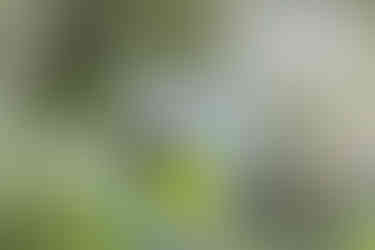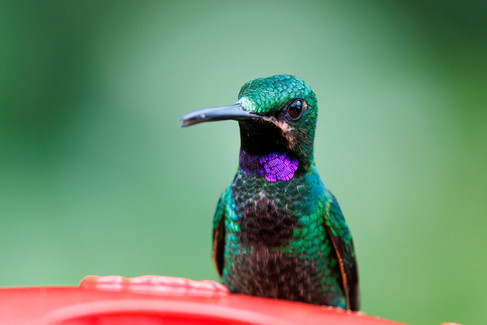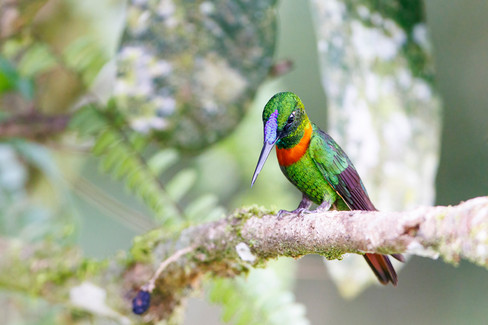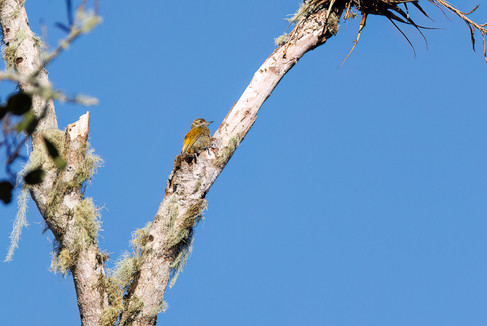8/26/2023 - 9/4/2023
Carmen and I were looking forward to a return to Ecuador. Last November, we had visited the Galapagos (posts here and here); bookending it with a day-trip up Antisana and several days in the Mindo area, including a visit to Angel Paz's place. We had scratched the surface of what Ecuador had to offer, and we wanted to see more. We did not have a lot of time, and, as always, money was a concern. We would not be going everywhere we wanted. Specifically, we cut a return visit to Angel's place and a visit to one of the Amazon lodges. This was going to be a relatively short trip that covered a couple days near Quito and then a somewhat traditional route out to visit the Guango, San Isidro, and Wild Sumaco lodges on the eastern slope of the mountains.
We were looking at the end of our trip. Time is an ever flowing river rushing past, and, as with most vacations, the current seems to always push us along a bit too quick. This post is actually going to swim back upstream a moment. Before leaving San Isidro in the last post, we headed to La Brisa for an afternoon.
La Brisa -
La Brisa is a short drive back up the highway from San Isidro. It is another place that could use a larger sign. You pull in, park, and then take a short walk to where the hummingbird feeders are located. The fee is a simple $5 per person, and there is a small box to place your money in. Located in the middle of a large verbena/portersweed garden is a covered pavilion with a couple of old couches in it. The hummingbird feeders are located here, and the birds split time between visiting the flowers and the feeders. There was one new hummingbird to see here, and we were pretty much here solely to see and shoot it. It is closely related to Carmen's favorite bird from our last trip to Ecuador, and it is the closest thing she is probably ever going to get to finding a "spark bird". This would be the bird she affectionately named the "puff boot motissimo", or "puffy booted little motmot". Birders would call it a White-booted Rackettail. The Peruvian Rackettail is similar to its counterpart in every way; except it has cinnamon/rufous boots. Some organizations consider the species to be conspecific. Regardless, we were here to see this bird; although it is an expected bird at Wild Sumaco.
La Brisa is probably best visited in the afternoon. As the sun lowers, it moves to your back. This also means you need to get out of the shelter; as the building will cast a shadow on your subject. A bright, overcast day would probably work best, and I thought that is what we had right until we arrived, when the sun came out. We spent the first hour or so there just watching the action. Yes, I tried shooting at times, but the lighting was awful. We waited and relaxed. Then the light got better, and I did some shooting. The feeders were very active and were being quickly drained. By the time we left, two feeders had been emptied; leaving just the couple outside the shelter, which worked out just fine for us. We had: Sparkling Violetear, Lesser Violetear, Long-tailed Sylph, Bronzy Inca, Gorgeted Woodstar, Violet-fronted Brilliant, and, of course, Peruvian Rackettail. A Hourse Wren building a nest with some feathers and a bit of snakeskin and a Bananaquit rounded out species seen here. We spent a little time in broken conversation with a couple from southern Ecuador. They were hitting some of the lodges up north and doing some photography. Shooting went fairly well, and we stayed until about 5:30 PM.
As I covered in the last post, we had a bit of excitement on our return from La Brisa, but everything worked out. The next day, we headed to our final destination of this trip.
Wild Sumaco -
We started our trip to Wild Sumaco with an overwhelming sense of deja-vu. We had, literally, been down this road before; uust a few days before when we missed our turn and drove an extra 45 minutes south of where we needed to be. So, it was not with a wild sense of travelling into the unknown that we hit the road after our final morning at San Isidro. Instead it was more of a slow plod that started with stopping in Cosanga at the exact same location we had stopped two other times to get out bearings. At least this time we were only stopping to allow Carmen to get some pictures. We even doubled back across the road to buy gas, my first Coke of the trip, and supplies for the ever fun game we like to call, "what do Doritos taste like here?" Rather bland.
Weekend traffic was heavy - as in heavy trucks. I was on a mission, and there is nothing more fun than driving some mountain roads. So, there was a lot of passing. Much to Carmen's disappointment, there just were not a lot of places to pull over for pictures along the road. In fact, there were really none. Any stopping would have entailed pretty much parking in the road for her to jump out and take some waterfall/scenery shots. Neither one of us were quite willing to do that; although it probably would have been just fine. We finally arrived at the small town where we would turn and head up a rocky, community road to Wild Sumaco. I was not sure what to think, here. Google maps is purposely blurred here. If you ask for directions, Google will tell you that Wild Sumaco cannot be reached. Needless to say, it can. In spite of the warnings about the conditions of the road from other people, the road is perfectly fine. Yes, it is rough, but it is drivable; probably even with a normal car. Our small Renault Duster SUV handled it just fine.
Wild Sumaco was the one hiccup in our plans. We had planned to spend four nights here. In the end, we could not get a room for that many nights, and we had to just shorten our trip to two nights here. We really could have used at least one more. We had our best birding of the trip here. We were at a much lower elevation than San Isidro and especially Guango. There is an overlap in species, but also a good deal more. To Carmen's joy, the Night Monkeys were swapped out for day monkeys, Black-mantled Tamarin to be exact. We got in, got into our room, and were immediately shuffled in for lunch. The food was good but more typical of what we had on our first trip to Ecuador. We were informed that our guide in the morning would be Byron and that we would meet him at 6:00 AM on the deck. We were also informed that there was a 3:00 PM feeding of the Plain-backed Antpitta coming up if we cared to go.
We did, and we had yet another incredible but fleeting experience here. We were going with a local guide to the place where the antpitta is fed. It is a short-ish hike into the forest. Along the way, the guide pointed out a few birds. Blue-rumped Manakin was probably the highlight. Like every other antpitta feeding I have been to (and I am tallying up a good number by now), we were brought in and positioned in a specific spot. The guide will go down with the food and, once the food is placed, it is a waiting game. The guide will variously make small imitative whistles, or shakes a food container, or calls ("venga! venga!" at Angel's place), or even plays (only once have I seen this) for the bird. The bird, of course, decides if it wants to come in. In this instance, the guide whistled a few times, and the bird showed up shortly after. It picked up every worm it could find in its bill and posed around with the huge gob of them hanging out of its beak before heading off. We laughed about it, but I was hoping that this was not it. We waited while the guide periodically whistled. There were more worms located on a nearby branch. While waiting, we suddenly heard a small ruckus coming down the hill behind us. Whatever it was, it was making a lot of small animal-like noises and moving very quickly. It was also incredibly small, because it was shaking the vegetation as it moved but not visible over it. This commotion moved down the hill and barreled right through the clearing where the antpitta come out into. All we could say was that there was two things chasing each other, they were small, and they were dark with some reddish fur. The guide said they were "perrito de monte". That meant nothing to us, and it all happened so quick, there were no photos. We asked Carolina (the manager at Wild Sumaco) about it over dinner, and she came back with bush dog. Incredibly rare. Never seen except on trail cams. We were very lucky. Here, I thought we were lucky because the Plain-backed Antpitta came back, again. We walked back out, and the guide lead us through a small coffee plantation where we had a few birds feeding.
We spent a while out on the deck here, and the hummingbird activity was pretty intense. The couple we ran into at La Brisa had been here and stated how difficult photographing some of the hummingbirds here could be. After a few minutes, it was easy to spot the problem. The violetears. There were both Sparkling and Brown Violetears here. Both are very territorial and aggressive species. Anything else coming to the feeder had to wait for the violetears to leave or be willing to fend them off. You really only had moments to try and get a shot of a perched bird. Everything was very skittish, as well. Somehow, they were not really used to people being nearby. There were quite a few species here. Golden-tailed Sapphire, Violet-headed Hummingbird, Black-throated Brilliant, Many-spotted Hummingbird, Brown and Sparkling Violetears, Green Hermit, Fork-tailed Woodnymph, Wire-crested Thorntail, and Gould's Jewelfront. It would take until the last day to get pics of some of these. Some, I would have to settle for pictures of them on a feeder.
To Carmen's delight, the tamarins also put in an appearance. She thinks they are cute. I think their little clawed hands make them kind of creepy.
The next morning, the birding started at 6:00 AM. Byron was our guide, and he was pretty sharp. The night before, Carmen and I had talked about the guiding here. In general, I do not give targets. I feel that it leads to over focusing on one bird. I usually explain where we have been birding and a bit of what I have already seen. My hope is that we end up birding the area together as opposed to being guided towards a specific target. This does not always work well. So, Carmen suggested I provide some targets. The problem is, I only knew of one target in the area. I told Byron a bit about where we had been and what we had seen. When he asked about targets, I asked to be shown the specialties of the area and to look for the Coppery-chested Jacamar, which is really a specialty of the area. He suggested a few other species, and we got things underway.
The forest here, is thick, and the birding is difficult. That Byron (or any other guides we have every birded with in the South American rain forests) ever spot anything is a bit of a miracle. Needless to say, photography is near impossible at times. A lot of times you are looking at birds in pieces. You are seeing some wings and a bit of a tail from behind a leaf. When the bird moves, you may see some of the eye and part of the head from behind another leaf. Eventually, you (hopefully) get enough views that you recognize it. While you are piecing this together, the guide has long ago provided an ID and moved on, but I like to look at the bird and pull together fieldmarks. I study ahead of time. While I am far from an expert (bordering more on outright dunce by guide standards), I at least have an impression of what most of the birds look like when given a name. Looking at the bird, I can usually piece together a few fieldmarks. Sometimes, I have to take the ID on blind faith (looking at you Euler's Flycatcher). All of this is just a long-winded way of saying I miss birds at times, and there are very few photos of what I did see.
Luckily, we had a car and could move around a bit. Some of the lodge trails are a ways up or down the road. We also did a lot of birding along the road. My favorite part of the morning was just standing at a mirador that overlooked an immense valley. A Great Potoo was roosting in a tree across the valley. Unfortunately, he was mostly obscured by leaves. While standing there, we watched as Russet-backed and Crested Oropendola few from tree-to-tree down in the valley. Chestnut-fronted Macaws gracefully soared about and perched in the treetops below. Closer, a mixed flock with a Little Woodpecker moved through. Maroon-tailed Parakeets occasionally screeched by overhead. It was a beautiful and lively morning.
We finished up the morning with a long walk to go look for Band-bellied Owl. When someone says you are going to go look for an owl roost, I generally get the impression you are going to be looking up. Not this time. We walked a ways on a trail and then stopped. The guide then stared down the edge of the steep incline running downhill from us and says, "It's here!" In the end, we had to walk down trail a little and then try not to fall down the side of the mountain as we stepped off the trail and descended a ways. About 40 foot downhill, he stopped and pointed sideways. Slightly above us and another 40 foot or so away was the owl perched in some shrubs. He was not impressed by our efforts to appreciate him. I snapped some shots, and we got out of there.
We returned to the lodge for lunch and a little bit of noon-time downtime. I spent my time on the deck. This was time for birding and not time for monkeying around. Of course, no one told the monkeys that.
I did sneak in a few birds. The funny thing here was that I had asked Byron about banana feeders out here. He said the birds do not come to the bananas; only monkeys. We had just gathered back up to head out for some afternoon birding when the oropendolas came in. Some landed in the huge Cecropia tree behind the deck. Then one casually walked over and started eating the bananas. We all laughed about it. We had just found the only banana-eating bird this side of the mountains.
The afternoon was much slower. We birded the small coffee plantation across the road. We birded up the road. Everywhere was really quiet. It was just hot, and not much was moving. We did get some decent looks at Paradise Tanagers, and that is really hard to complain about. A Spotted Tanager was seen gathering nesting material. We ran across a small mixed flock and had Plain-brown Woodcreeper.
The sun was starting its slow decent by this point, and we headed back to the trails of the lodge. As we walked the trail, the guide could hear a trogon calling. He would call back, and we slowly got closer. As we were standing there, a sudden commotion broke out above us. We looked up just in time to see a Short-tailed Hawk bursting through the canopy with something in its claws. It swooped over us and disappeared off into the trees. We did not hear the trogon again....
We walked on along the trail and picked up a couple of new birds. Rufous-naped Greenlet and Black-streaked Puffbird were nice additions, and we got good looks at them. We walked to an area where the guide knew of a nesting jacamar. We had checked the area in the morning without luck. Now, with the sun setting across the valley, we were having the same amount of luck. The guide knew I was tired. I had twisted a knee earlier on the trip, and, in favoring it, had aggravated the other. So, I was hobbling a bit. He asked if I was willing to go downhill to look for the jacamar. Sure! Well, again, I should have asked more questions. Downhill was a very steep descent on rotten, wooden stairs. In places, the treads were totally missing, and it was nothing but large, round river rocks. Not the best of footing. I struggled down quite a ways before asking about how far we were going. As far as I could tell, the trail descended all the way to the valley floor. He said we were close and played for the bird. It perched right in front of us. As requested, Coppery-chested Jacamar. Light was non-existent, but I pulled out a few shots, and we trudged back uphill. Even Carmen was winded by the time we got back to the top.
We walked back to the deck and thanked Byron for his time and patience. We had a little bit before dinner, and we spent the time relaxing on the deck. As we were sitting there, a hummingbird came in to feed. I had seen this bird the night before, right about the same time. I did not have my camera with me and made some mental notes about the bird. I came up with an ID, but the bird was supposed to be rare. I had questioned Byron about it earlier in the day. As expected, he named all the common birds that I already knew. I knew this was different. Later, he must have been thinking about it, because he said, "you think you had a Rufous-vented Whitetip, huh?" I explained that it was what I was thinking, but that I was not expert enough to make the call for something rare to the area. He said nothing more. Well, the bird was back, and I had my camera this time. I was also right.

The next morning, sadly, we were leaving. We had a lot of time to kill that day. The drive back to Quito was about 4 hours. We needed to stop at San Isidro to visit Gonzalo, but that would not take a lot of time. Our flight did not leave Quito until 11:30 PM; so, we did not need to be at the airport until 8:30 PM. Luckily, we were able to stay at Wild Sumaco until noon. That gave us time for breakfast and to hang out on the deck. I had originally said that I wanted to go to the antpitta feeding in the morning. White-crowned Tapaculo shows up there in the mornings sometimes, and it would have been a good bird to see. The skies had opened up and poured rain most of the night, though, and I was not looking forward to walking muddy trails. I decided to stay and try to catch up on some pics from the deck and bug light. This proved to be a mostly good idea.
The only downside was that I kind of screwed things up for Carmen. A Tyra was known to come visit the bananas in the morning. Carmen was hanging out on the deck and waiting to see if it showed. I checked the bug lights and then went to sit with her while she waited. We were chatting when I looked over at the Cecropia tree. I could see something moving on the bananas, but I was looking through a bush and could not really see well. I mentioned there was something on them and then leaned to where I could see better. I got so excited that I exclaimed (loudly), "it's the Tyra!" It turned, looked at us, and scooted out of the tree. Carmen, who had turned to fetch her binocs when I first mentioned something was in the tree, missed it altogether. (it did not come back and i felt super bad)
What went much better was the birding. I was able to catch photos of a few species that had eluded me on previous days. There were also a few species coming into the bug light, and I was able to photograph them. I was happy to get some Western Fireeye and Black-billed Treehunter shots at the bug light. The highlight was probably the Black-faced Antbird. While there, an Andean Cock-of-the-Rock flew by overhead. Later, a pair of Green-backed Trogon showed up. At the hummingbird feeders, I finally managed a single Fork-tailed Woodnymph shot. This was not a lifer, but I just like to get shots of the birds I see. Off the deck, there was quite a bit of activity, too. The Cecropia tree was very busy with oropendola. Both Russet-backed and Crested came in, but I missed a shot of the Crested. Palm and Blue-gray Tanagers came by. The Blue-gray here have white patches on their wings. There were also Yellow-tufted and Golden-olive Woodpeckers in the tree. Yellow-throated Toucan stopped by to pose for a bit, and then a lovely female Gilded Barbet showed up to feed in the tree. Montane Foliage-Gleaner and Wedge-billed Woodcreeper picked through the nearby trees. All in all, a very busy morning. The rains had brought cooler weather and a lot more activity. If only we had had this weather the day before.
I was just returning from a trip to the bug light when I spotted my most-wanted hummingbird on the deck. Even better, it was perched on a small stick near a feeder. I raised my camera, got it pointed, and pressed the focus button. The camera whirred, made a couple motions and then gave up. Part of the joys of mirrorless, at least with Canon, is that they love to focus to infinity and then give up. That is exactly what happened here. By the time I had thumbed the focus ring to nudge it back to life, the bird had flown. Dejected, I sat down in a chair on the deck and waited - hopelessly. Shockingly, the bird returned a short time later, and I had some shots of a beautiful male Wire-crested Thorntail.

Not long after, it was time to leave. It was a bit closer to 11:00 AM than noon. I had heard from Gonzalo, and my painting was finished. We had planned to spend a couple hours travelling back down to the main road. Along the way, we were going to search for butterflies for Carmen. Unfortunately, the rain and coolness of the morning hampered that quite a bit. Butterflies love the heat. We did find a few new ones for her, including an 88 that she had spotted the previous day and wanted pictures of. We ran across one large mixed flock, and I pulled a couple photos from it. Yellow-browed Sparrow, which I had really hoped for better shots of, and White-winged Becard.
Not far after that, we hit the end of the road.
The drive to San Isidro was uneventful. There was little traffic on the road, and we made good time. We even spotted the turn-in on our first pass. We arrived at San Isidro just in time to bump into Gonzalo, again. We walked to the reception desk and talked about birding along the way. There, spread out on the desk was some of Gonzalo's latest work. Sitting there amongst it was my painting. It looked even better in person that it looked in the photo he had sent me. You can see the various sketches along with the note about the day we had seen the bird on the Jumandy trail. Yes, of everything I could have asked for, I asked for a Rufous-headed Pygmy-Tyrant. It is a cool bird and a great reminder of a great day of birding and the "trail of death", as I had taken to calling it.

While there, Gonzalo snapped a picture of the three of us so he would remember who the pesky American is that keeps What's Apping him. I plan to get in better shape and come back conquer that trail and the Peruvian Antpitta some day. So, he better get used to hearing from me.

We said goodbye and started the drive back. We made it to Quito without incident. The car return went without issue, and we were dropped off at the airport center a good three hours or so before our flight. The airport center is a public place with restaurants and shopping that is located directly across from where passengers are dropped off for flights. We ate at the same place we ate at last year and then found a quiet place to catch up on journaling. Eventually, we started the process of jumping though the various flaming-hoops of check-in and airport security. We got onto the plane and tried to get some sleep on the short 5 hour flight to Atlanta. Customs, baggage re-check, and another set of security officially put us back in the US. Things went pretty standard from there. Much like the started this trip, we were going to finish it with only a few hours of sleep. We had a day to relax before starting work the next day, though. So, we would have time to catch up.
It was a great trip, and we enjoyed it. Ecuador is an amazingly beautiful country. While the birding was slower than I had hoped, we did finish with around 230 species on our list. Of those, 83 were new species for me. I do plan to return to Ecuador. It is a big world, and there are a lot of places to see, but I think Ecuador is special enough to warrant another trip.
Here at home, migration is kicking up, and I hope to get a few posts in before I take off on my next big experience. Stay tuned!
Thanks for reading,
Mike






































































































































































































































Comments